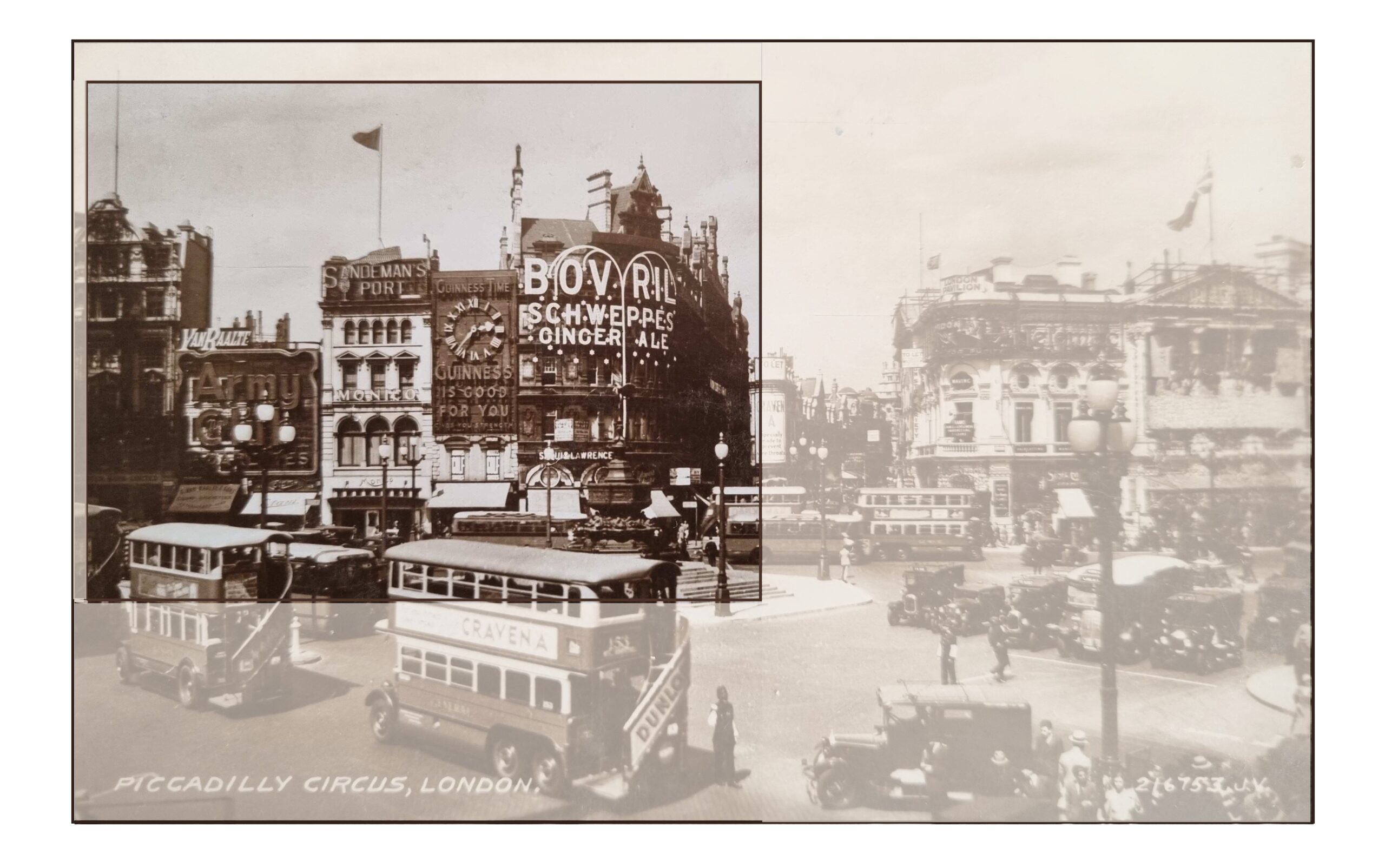
In the first decade of the 20th century electricity first lit up advertisements for Mellin’s Food and Perrier on Piccadilly Circus. Many more followed. Then there was neon, creating an expanse of dancing illuminations. These in turn were succeeded by state-of-the-art billboards. But what of the unfortunate buildings behind these ‘Piccadilly Lights’, as they are known? What secrets lurk in the block known to urban planners as the Monico, after the restaurant that once stood at its heart?
The site is bounded by Shaftesbury Avenue, the circus itself, and streets Denman, Sherwood and Glasshouse. The shape, which can charitably be described as irregular, came about in the 1880s when Shaftesbury Avenue was carved through slums by the Metropolitan Board of Works (‘MBW’) to connect Holborn to Piccadilly. The junction thus created was a disaster – a space, as Jerry White puts it, “the language of geometry [is] inadequate to describe”. Although the Café Monico itself added some panache to the area for over eighty years, its luxurious dining saloons were hidden behind a set of jumbled, awkward buildings. This made the block the poor relation in Piccadilly Circus, far less grand and composed than the London Pavilion, Criterion Restaurant, Swan & Edgar’s department store and the County Fire Office. It also made it vulnerable when lax laws and electricity conspired to create one of the greatest London marketing opportunities of the early 20th century: The Piccadilly Lights.
→ The Monico Block. Piccadilly Circus, which hasn’t been circular since the 1880s, is the meeting point of glamourous districts around Piccadilly and the darker corners of Soho to the north-east.
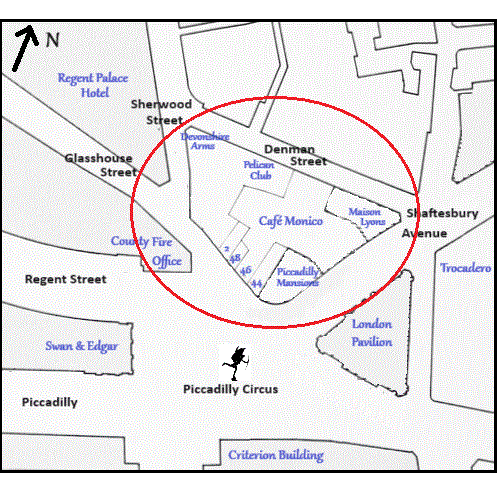
![]() Film-star Looks & Fast Ladies: The Café Monico
Film-star Looks & Fast Ladies: The Café Monico
We had a rag at Monico’s. We had a rag at the Troc,
The Varsity Students’ Rag, by John Betjeman
And the one we had at the Berkeley gave the customers quite a shock.
Then we went to the Popular, and after that – oh my!
I wish you’d seen the rag we had in the Grill Room at the Cri.
Opened in 1877 by Swiss-born British brothers Giacomo and Battista Monico, the restaurant to which they gave their name followed the ending of their involvement in the Adelaide Gallery near Charing Cross, run in partnership with the famous Gatti family, who originated from the same Swiss valley. The new enterprise was located at 15 Tichborne Street, on a site previously occupied by livery stables and a billiard hall. The brothers rebuilt it and gave it a facade in Italianate style. There was a grand café saloon and, according to their publicity, “the most perfectly ventilated billiard saloon ever constructed”. It offered post-theatre suppers and stayed open until 12:30am. The cuisine was broadly French, Italian and English.
In 1720 John Strype had described Tichborne Street as “meanly built, neither are its inhabitants much to be boasted of”, and fellow historian Henry Wheatley claimed nothing much changed in the next 150 years, so it was an odd choice for the Monico brothers. Unless, of course, they knew what was coming.
Soon after they opened, demolition of houses on the south side of Tichborne Street for the new Shaftesbury Avenue meant their address changed to 46 Regent Street. More importantly, the Monico went from a side street to a prime location overlooking the circus without moving an inch. Business boomed, and in 1890 the brothers erected a new wing that doubled the size of their establishment and provided a fine entrance in pink granite and terracotta on the new avenue. The Monico now featured lavish walnut panelling and a white marble staircase leading to such beautifully-appointed chambers as the Louis XV and Louis XVI Rooms, the Buffet, Brasserie, Renaissance Saloon, Coffee Room, Smoking Room, International Hall, Parisian Room, Oriental Room, Winter Garden and Grill Room. A saloon overlooking the Circus was appropriately called the Circus Room. Images of some of these are on the Historic England website here. There was also orchestra music for lunch and dinner, passenger lifts, and staff bedrooms on the third floor. The larger function rooms proved popular for institutional and regimental dinners. The Monico had gone from an obscure eatery to a vast and luxurious rival for the Criterion and Trocadero nearby.
Renowned restaurant critic Lt. Colonel Newnham-Davies visited the newly enlarged Monico. He opted for the five-shilling table d’hôte in the Renaissance Saloon, ready to hear an amusing tale promised by his guest, a stockbroker. The broker began his story but never managed to finish as the food, waiter, and maître d’ interrupted the telling time and again. The meal was of a quality far surpassing five shillings; Newnham-Davies suspected special treatment.
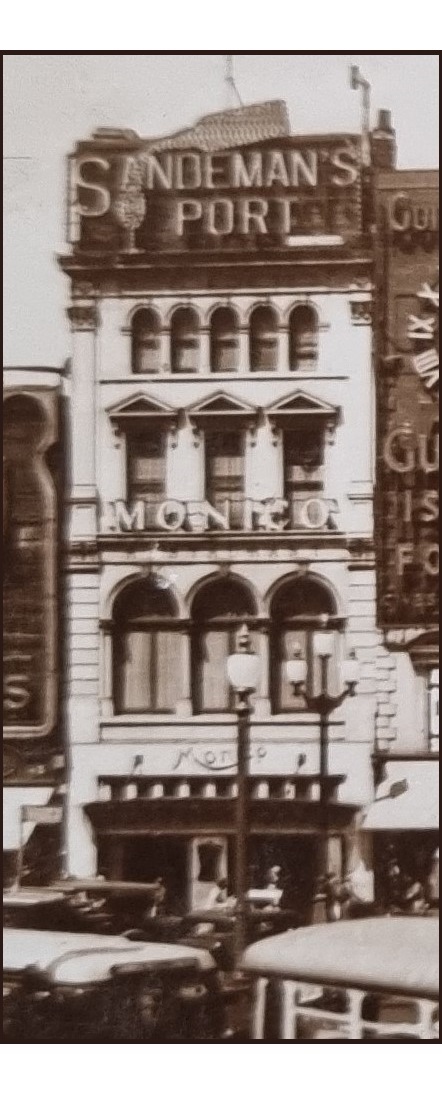
In its early years the Monico hosted competitions, including chess tournaments and the first British Weightlifting Championship in 1891. A licence permitting dancing at private events was granted the same year, but there were earthier delights lurking in the shadows. Piccadilly was the centre of high-class prostitution and the Monico wasn’t above allowing entry to such women and their clients for drinks or supper. In 1902 Robert Machray wrote on Piccadilly after dark, and discussed an unnamed but barely-disguised Monico:
“Just outside its vestibule – that giving on the circus – you will see a row of men … staring with bulging gooseberry eyes at the French demoiselles, whose main camping ground is the Colonnade of Regent Street; the same men, or their doubles, seem to stand there every evening. Within the café, as you enter, is a picturesque little shop, where of foreign newspapers you may have ‘what you please, m’sieu!’ Still further within, you may have what you please; you may call for what you like – if you have the price. You quickly see that though the whole atmosphere of the place is foreign, yet the brutal custom of exacting payment for everything you receive is rigidly insisted on with true British bull-dog pertinacity. … [Y]ou perhaps descend into the grill-room, where by way of whetting your appetite you may perchance see a … little Jap following two pavement ladies down to supper.”
Clearly, despite its genteel afternoon teas and pre-theatre dinners some of the dining saloons, particularly in the late evening, had a bohemian atmosphere that respectable Victorians may not have found so welcoming. To be fair, the Monico was probably as respectable as it could be in the Belle Époque given its location, and the Trocadero and Criterion had similar issues, with the Criterion ‘American Bar’ even having a highly visible gay clientele just as Oscar Wilde was being condemned.
The Monico’s reputation wasn’t helped by stories in the press. In 1897 James Orrock, a successful watercolourist, sued Giacomo Monico after a barmaid opened a soda water bottle and let the cork fly straight into his eye, leaving him unable to paint for months. In 1902 Mary Pask, buffet manageress, lay dead in her bedroom ‘above the shop’ for a fortnight because staff believed she was on vacation. Three years later the Monico received the unwanted endorsement of Lady Violet Proctor-Beauchamp, daughter of the Earl of Roden, during the trial of her lover and ex-MP Hugh Watt for attempting to procure the murder of his wife. Lady Violet claimed to have dined with Watt at the Monico every day for a year. Watt was found guilty, as no doubt was the Monico in the court of public opinion, of being a place where ‘fast’ women ate. In 1909, an elderly Parisian precious stone dealer, Frederick Goldschmidt, was the victim of the sensational ‘jewellery robbery in the lavatory’. A jockey, Herbert Grimshaw, and cheesemonger Joseph Higgins snatched a bag of pearl necklaces and other gems valued at £40,000 (£4m today) as Goldschmidt washed his hands in the gents. Never has personal hygiene proved so costly. It was claimed the theft was an international plot featuring the most daring criminals in Europe, which no doubt added a certain frisson when using the Monico’s facilities. Grimshaw got three years’ penal servitude, Higgins fifteen months’ imprisonment.
It was certainly not widely reported in 1893 that Battista Monico had died at the restaurant of typhoid. Giacomo passed away at his villa in Lugano in 1911, with the First World War on the horizon. He left £75,000 (£7 million today) in his will. Two years later, at a meeting of the ‘Entente Cordiale club’ at the Monico, Baron D’Erlanger spoke of the ability of the proposed channel tunnel to promote peace between nations. Nine months later the war to end all wars began; eighty years later a tunnel finally opened. Perhaps they should have dug faster.
Between the wars the advertising signs became a big draw for film makers. As a result, the Monico’s exterior appeared in the silent classic Piccadilly in 1927 and in Alfred Hitchcock’s Blackmail two years later. A 1930 film of the ‘girl singer makes good when the star can’t appear’ type, Piccadilly Nights, featured both the exterior and interior. About this time the London County Council (‘LCC’) gave up the battle to have the signs removed. Byelaws thought to make them illegal had proved toothless, and leaseholders of the buildings on the north and east sides of the circus realised they were sitting on a goldmine. Thus, by the late 1940s the Monico entrance at 46 Regent Street above the ground floor had been abandoned to the neon signs, and was shorn of its external stonework decoration to make this easier.
The Monico began to decline in the 1930s. It stayed open through the war to a limited extent – it even managed to host the annual vegetable dinner of the Food and Wine Society in May 1940 – but having made it through hostilities passed out of family ownership in 1947. It fell into the hands of Charles Forte, of the eponymous hotel chain, in 1953. 46 Regent Street, along with 48, became ‘Forte’s Popular Restaurant’ while the Monico staggered on behind in a twilight world of its own, a cheap shadow of its former self. By 1959 plans by developer Jack Cotton to replace the entire block with a 14-storey, 172ft tower seemed certain to proceed, and Forte departed. What survived under the Monico banner, including the entrance on Shaftesbury Avenue, closed the same year. Demolition began in December.
Cotton then made a catastrophic blunder. His initial planning application had ruffled few feathers, with the LCC and Westminster City Council both onboard, but in late 1959 he held a press conference where he gloated over his success and used illustrations that pulled no punches. After an outcry, the Government felt obliged to call a public enquiry. This came out against the plan, but its conclusions focused on the meritless design and its likely failure to fit in with a comprehensive Piccadilly Circus redevelopment scheme, so this was hardly a win for conservationists. Nevertheless, demolition stopped with the remaining buildings left standing in front of what looked like a bomb site. Cotton announced in 1961 that Dr Walter Gropius would assist in producing a revised design. The father of Bauhaus could certainly have brought a lustre to the site, but the idea seems to have died with Cotton in 1964.
Proposals for a comprehensive redevelopment of the circus were put forward and rejected in 1961, 1962, 1966 and 1972. Throughout this period, only short lets were available for surviving buildings around the Monico site and they fell into near-dereliction. Let us now take a look at the history of some of that disorderly rabble of structures.
![]() Unpretending Little Shops: The Monico’s Neighbours
Unpretending Little Shops: The Monico’s Neighbours
The structures around the Monico were fit for a side street, but with the demolition of the buildings opposite them in 1877 they were thrust into the unforgiving glare of Piccadilly Circus. They weren’t up to the job, so it is no surprise that they were hidden by neon in the 20th century.
The modest building at 44 Regent Street (ex-14 Tichborne Street) probably dated from the early 19th century and was occupied over the years by an engraving business, an auctioneer, a haberdashery and from 1834 Jarrin’s the confectioners. In 1820 it was described – by a property agent – as “a substantial dwelling-house and spacious back premises”, containing three bedrooms, two kitchens, cellar, “well-proportioned drawing room, neatly painted” plus the double-fronted shop itself.
Messrs. Amery and Loader, gentlemen’s hosiers and shirtmakers, probably arrived just as the Monico brothers moved in next door. They particularly targeted visitors from across the pond: “Our American friends in want of shirts, gloves, cravats, and all the minor etceteras of a gentleman’s wardrobe, will find all these things of best quality and at moderate prices in an unpretending little shop, 14, Tichborne-Street, a step from Regent-Street, kept by Amery and Loader. These young men are ambitious to give satisfaction”. When targeting the British, they emphasised their role as “East India and Colonial outfitters”. The business continued into the 20th century. Charles Loader died in 1911 and as if to emphasise the passing of an era, the proving of his will was reported in the press alongside that of Giacomo Monico. Not quite so wealthy, he still left £18,000 (£1.7 million today).
Amery and Loader gave way to W. Abbott & Sons, purveyors of shoes. About this time Guinness adverts first appeared on the building, which from 1930 included a large working clock. It is said that a Scottish army officer climbed to the top of the Guinness sign, in his kilt, on VJ day. Abbott and its shoes were in turn supplanted by Boots – the chemists – although I’m unsure whether this was a temporary move from the 24-hour branch in the Criterion Building or that the company decided the area needed a pair of Boots. Either way, it didn’t last long. In the 1950s the ground and first floor frontage was mutilated to enhance retail window space. Boots was replaced by Air India, but after that the store was frequently empty. Its last occupant was poster company Klepton.
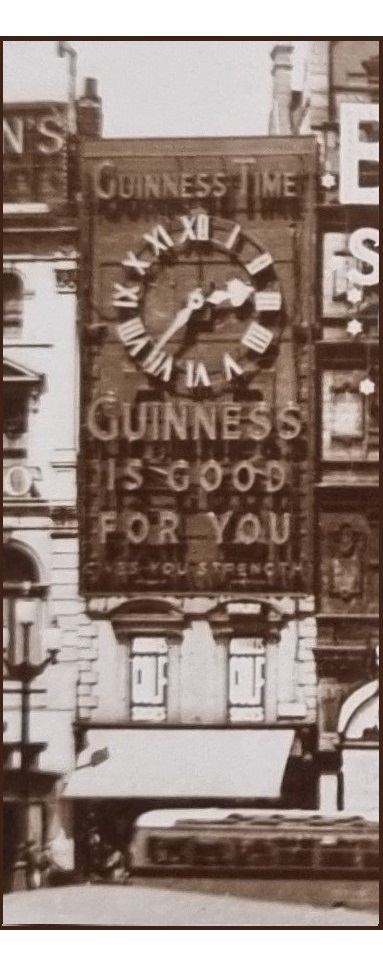
Among the earliest signs to overlook the circus was one for Mellin’s Foods above 48 Regent Street, advertising the pharmacy below. This had arrived by 1865, initially as Marshall and Mellin. By 1872 the business led by Gustav Mellin had began to specialise in biscuits for infants and invalids, which it also supplied to other retailers. In the 1890s it adopted a novel marketing approach, sending out free samples with a leaflet of Shakespearean quotes on the feeding of infants. Mellin remains a brand of baby food to this day, but by the mid-1920s the shop had closed, replaced by a branch of ladies’ lingerie supplier Etam. As Etam didn’t use the facade to advertise itself, the space was combined with that above its neighbour at 2 Glasshouse Street. Etam was a British franchise of a German company, severing ties at the start of hostilities in 1939. It remained a successful business but this branch closed in the early 1950s, the premises absorbed into the new Forte’s Popular Restaurant in 1954.
At 2 Glasshouse Street Edward Piercy, carver, gilder, and picture dealer plied his trade for a decade before bankruptcy in 1833. William Stacey, tailor, went the same way fifteen years later, but the premises then found its vocation: Tobacco. Cigar dealer Lloyd & Co. moved in, renamed Van Raalte soon after. In 1859 it was gutted by fire but soon repaired, and Van Raalte would stay put for a century. Its name appeared at the top of the building from the early days of the Piccadilly Lights, and the company may have had a hand in the Army Club Cigarettes sign that covered both their own store and Etam in the 1930s. In June 1939 the two stores were damaged by an IRA bomb aimed at the neighbouring bank, the pavement strewn with a bizarre mix of cigars and lingerie. In 1958, the Illustrated Sporting and Dramatic News noted that for “sheer selection … they beat even some of the big cigarette shops in Amsterdam” and recommended their own-brand Brazilian cigarettes, at 4s 2d for twenty, but the end was near. Van Raalte was another victim of the Cotton plan, closing in 1959 and standing empty until the threat of immediate redevelopment was lifted.
→ The Army Club cigarettes sign covering Van Raalte and Etam, two shops overwhelmed by the scale of Piccadilly Circus.
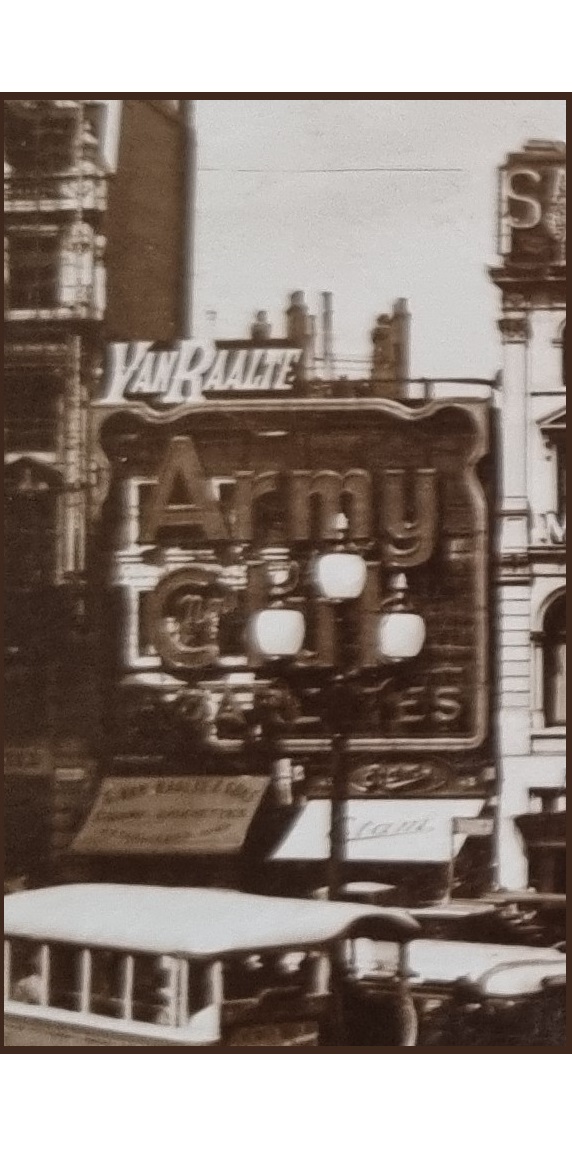
![]() Totally Uninspired: Piccadilly Mansions
Totally Uninspired: Piccadilly Mansions
The southern-most corner of the block was described by the Survey of London as one of the most valuable sites in the metropolis. Unfortunately, what was built on this prestigious location in 1888-9 was Piccadilly Mansions, also known as 1-17 Shaftesbury Avenue. The MBW had rejected initial plans for the site as lacking in architectural distinction, but the final design was little better. Again according to the Survey of London, it was “elaborate but totally uninspired”. Its arched ground floor, wrapping around the corner of the avenue and circus, was the only elegant thing about it.
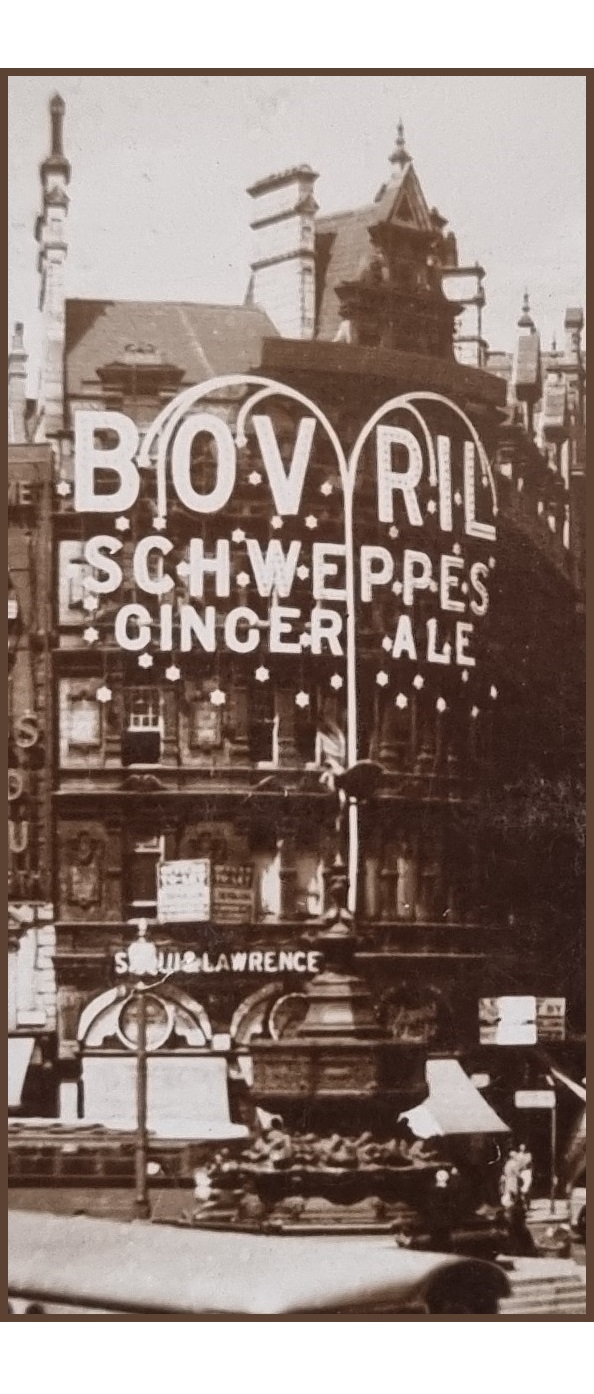
Prospective tenants were underwhelmed. Several ground floor shops were still empty in early 1890, as were all four upper storeys despite having baths, a hydraulic lift and electricity. This should have come as no surprise: A question mark was hanging over the building even before the plasterwork was dry. Authorities had quickly realised what a disaster the new road junction was, and that the demolition of Piccadilly Mansions along with the remains of Tichborne Street to properly ‘square off’ the circus would produce a more manageable and attractive space. This prospect haunted the block for eighty years; in the 1900s Norman Shaw was the first of many architects asked to make a silk purse out of the MBW-inspired sow’s ear. His master plan for the area would have swept away Piccadilly Mansions along with the London Pavilion. However, only his proposals for the west of the circus were executed; his design was just too controversial and money too short. Piccadilly Mansions survived.
The most significant tenant to move in was Stollwerck, a Cologne-based chocolate manufacturer that opened a shop unit. Then, in early 1891, reports suggested a new gentlemen’s club called the United Nations would take the upper floors. Fitting out started, then stopped, then legal action started. Announcements inviting applications for membership appeared in September, then silence. The club was never heard from again.
In 1893 a magnificent but wholly fictional Piccadilly Mansions apartment featured in a play, ‘A Life of Pleasure’, at the Theatre Royal Drury Lane. By this time the real building was less a swanky residential block and more a confusing mix of small apartments and offices occupied by theatrical organisations including talent agencies and costumiers. Some rooms were rented as cheap accomodation by local workers, among them waiters and prostitutes. In the 1930s a detective agency joined them. The offices were never popular and as the neon signs increased on the half of the building facing the circus, occupancy rates declined further.
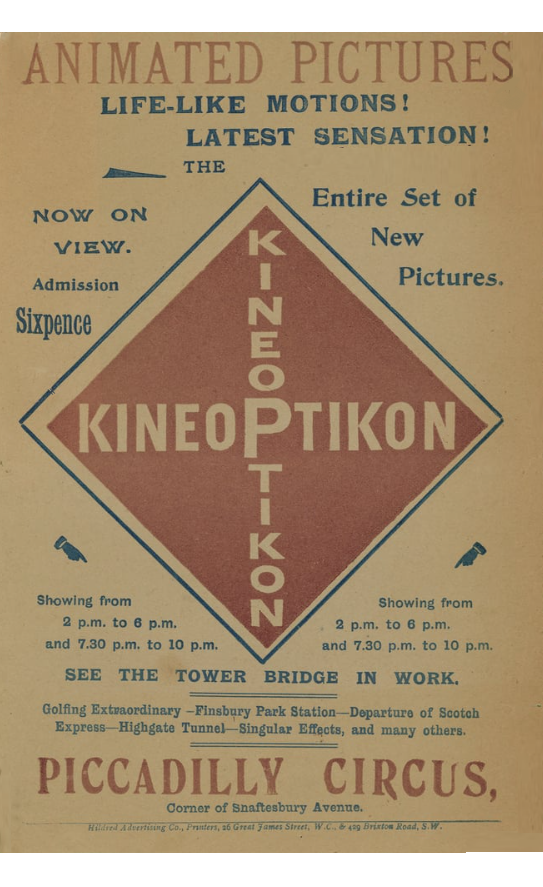
Below the offices, things had taken a surprising turn. In 1896 a new invention that produced moving pictures had been astonishing learned societies. Birt Acres, an American inventor, had shown his ‘kineoptikon’ at the Queen’s Hall to members of the Royal Photographic Society, and won the backing of Ludwig Stollwerck, of the chocolate-making dynasty. Ludwig was fascinated by all things technical, a fascination formed during his quest for a viable chocolate-vending machine. There was a stampede of promoters preparing to show the new invention to the public – for a fee. Acres wasn’t the first: The Lumiere brothers at the Polytechnic on Upper Regent Street in February, and Robert Paul at the nearby Egyptian Hall on Piccadilly on the 19th of March were ahead of him. Nevertheless, two days after Paul, Acres opened at Piccadilly Mansions in or next to the retail premises of his backer.
But where in the premises were the films shown, and was the building adapted? If so, Allen Eyles suggests, this may qualify as the West End’s first cinema. Sadly, little information is available. The premises was damaged by fire on the 10th June, possibly caused by the projection equipment, and this brought Acres’ endeavour to an end. But the basement – surely the most likely location – had not seen the last of moving pictures.
← An advertisement for the Kineoptikon. Other films shown included ‘A Visit to the Zoo’ and ‘The Derby’.
In 1934 another of the retail units was converted into the Eros News Theatre, named after the prominent statue in the circus which, it turns out, isn’t Eros at all but his brother Anteros, god of requited love. The Eros was tiny, with two hundred seats spread over the stalls at basement level and a tiny balcony at street level. At one point in the 1950s staff included Mr. Love, Mrs. Cupid and Mr. Parsons, and this was reported to the press for publicity. As news cinemas became less popular, the Eros switched to cartoons and, when its owner merged with the Classic chain, was renamed the Classic Cartoon Theatre. At this time, bizarrely given the fare on screen, the rear stalls became a notorious place of assignation for the Piccadilly rent boys and their clients. Families and children buying tickets had to be directed to the ‘better’ balcony seats. This became less of a problem when the Classic switched to feature films and took the Eros name once more in the 1970s to show soft porn.
![]() Sic Transit Gloria: The Brief Life of the Pelican Club
Sic Transit Gloria: The Brief Life of the Pelican Club
“… our conditions for membership were based entirely on a certain standard of behaviour. Drinking, gambling and a keen interest in racing were a prerequisite; the ability to pay for your drinks was desirable, but telling a good story was acceptable in lieu.” (N.T.L. Murphy, The Reminiscences of the Hon. Galahad Threepwood)
Regrettably, most occupants of the buildings facing Denman Street have been quite dull – with one notable exception. The Pelican Club opened at 21 Denman Street in 1887, when it was described as “the smartest development of Bohemia”. It was a rowdy drinking-and-sporting gentleman’s club, adopting as its after-dinner toast the creepy “Young women and old wine”. It had a skittles alley and shooting gallery, but members had a particular fondness for boxing – indeed a founder-member was the Marquess of Queensbury. The club hosted important bouts and sparring sessions and was involved in organising more elsewhere, and despite membership being mainly peers and other upper-class types, pugilists were honoured guests: Even John L. Sullivan, the famous American champion, dined there one night.
Boxing was, as now, a sport of dubious practices, and within weeks of opening the police attempted to raid the club during a fight. Although boxing-related problems arose throughout the club’s existence, and patience was soon exhausted on both sides, on this occasion a tongue-in-cheek response appeared in the Sporting Times:
“Committee of Pelican Club have issued notice that no policeman in uniform who has not paid entrance fee and subscription for current year can be admitted to club under any circumstances. Committee further instructed secretary to purchase Gatling gun, and mount same on roof; also to lay torpedoes in front hall.”
It will come as no surprise to learn that a number of journalists on the Sporting Times (known as ‘the pink’un’) were also members of the Pelican.

Another problem was the clubhouse. 21 Denman Street was ‘a cross between a disused Turkish Bath and a Baptist meeting hall’ (according to Murphy), too small and quite unsuited to its new role, so larger, purpose-built premises on nearby Gerrard Street opened in February 1890. Boxing continued there, drawing complaints that the street filled with “some of the roughest people in the world” when a bout was held inside. Ernest Wells, the owner, fought to maintain his club’s reputation in the face of the outrageous behaviour of his own members, who were often trying to avoid paying debts or being discovered by their wives. It was a fight he couldn’t win. Mired in legal action and controversy, the Pelican bankrupted itself within three years of the move.
← To our eyes, this 1892 advertisement for Dr. Ridge’s baby food is wrong on many levels, but its subtitle “Junior Members of the Pelican Club” shows the dubious boxing-related reputation of the club was widely known.
One man who was later inspired by tales of the Pelican was novelist P.G. Wodehouse, and two of his characters, including the Hon. Galahad Threepwood, are explicitly stated to be ‘old Pelicans’. In 1993 N.T.P Murphy wrote Threepwood’s ‘reminiscences,’ which in Wodehouse’s world are eaten by a pig so never see the light of day. Murphy claimed that only 16 of the 260 pages are complete fiction, with the rest based on true stories, many relating to the Pelican. Sadly, there are few physical reminders of the club. Number 21 survived the clearances in 1959 that saw the end of most Denman Street buildings, but finally came down in 1977.
Back in 1890, the Pelican’s departure from Denman Street left the way clear for a new incarnation of the Eccentric Club, originally founded in the 18th century, to use the premises until it too moved to somewhere more suitable …
![]() Thespian Eccentrics, Posh Lyons & Dancing Yanks: Rainbow Corner
Thespian Eccentrics, Posh Lyons & Dancing Yanks: Rainbow Corner
21-23 Shaftesbury Avenue, on the eastern corner of the block, was built around the same time as the adjacent Monico extension. Like Piccadilly Mansions, it was an uninspiring speculative development, conceived as a clubhouse or offices with shops below. Unlike Piccadilly Mansions, it was quickly occupied. A short-lived club called the Shaftesbury was followed in 1894 by the Eccentric, moving the short distance from the old Pelican clubhouse. The new location, deep in theatreland, was perfect for the theatrical membership the club had at the time. The premises consisted of a “handsome saloon for smoking concerts”, a large dining hall, card room, billiard room, and some bedrooms. Commissioned artwork included Eccentric in Paradise and Temptation of St. Eccentricus. There was also a clock, held in the beak of a stuffed owl, showing only the hours 12 to 4, as the early hours of the morning were when the club was most lively.
Was it eccentric? In 1896 the hon. sec. denounced claims that bohemianism in London was on the wane, claiming the Eccentrics were still as bohemian as their best friends could wish them to be. Evidence suggests this was true: In the dying minutes of 1895 a member had hailed a cab outside the club and demanded he be driven into the new year as soon as possible. In 1897 a member somehow managed to set fire to, of all rooms, a lavatory; it was claimed the fire was caused by overheated remarks regarding horse-racing results at Kempton Park. At the annual Music Hall Sports Day, amid sensible sprints, hurdles and cycling races there was the Eccentrics’ “Bicycle Obstacle Race”. In 1907, one S.A. Frankenstein wrote from the club to the Sporting Life, claiming champion wrestler Hackenschmidt should be challenged by Padoubney or Zbyseko Cyganiewicz, at which point the Sporting Life probably ran out of consonants. In 1908, despite a decent rail network, five daring members took a Humber motor taxi to Exeter where they had business. 31 hours and 414 miles later they triumphantly returned without mishap. A journalist recalled arriving at the club close to 4am and being served smoked haddock while a member at the piano played the bass notes with his fingers and the treble notes with the brim of his hat.
Its most eccentric move was, well, a move. The club’s search for larger premises had been common knowledge since 1912. Finally, in 1914, it relocated, out of Shaftesbury Avenue and this post, and into an utterly sensible former hotel in sedate and serious St. James, a location unsuited to its theatrical membership. For more on the Eccentric Club see my whimsical post “Where the Weird Things Are”.
Initially, the ground floor had been occupied by Cruickshank, a company selling children’s clothes – the place you went to buy sailor suits for young sons. Then came a branch of the British Tea Table café chain, aimed at the lower middle class. Its aim, however, was poor and it went bust in 1909 in spectacular fashion, amid boardroom disputes and legal action.
This failure, along with the departure of the Eccentrics, left the way clear for a far larger organisation to move in. The refreshment behemoth J. Lyons & Co., known mainly for its modest teashops, was riding high with the success of its new, vast ‘Corner Houses’ – one was close by in Coventry Street – and the Trocadero just across the road. It was also about to open the huge Regent Palace Hotel on Glasshouse Street. Lyons used the whole of 21-23 Shaftesbury Avenue to launch a new concept: ‘Maison Lyons’.
It opened in 1915. A cut above both the teashops and Corner Houses, it was spread over five floors: A patisserie, food counter and chocolatier on the ground floor, dining areas above. These served light luncheons, afternoon teas and dinners at reasonable prices. It also included a recruitment centre for ‘nippies’, as Lyons waitresses were known.
→ From left to right: Piccadilly Mansions, the 1890 Monico entrance, and part of 21-23 Shaftesbury Avenue. This scene is from 1915; the Maison Lyons is still being fitted out.
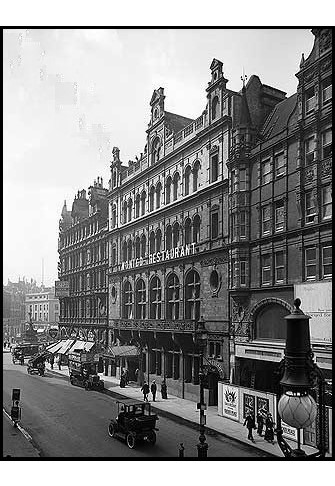
The only excitement this restaurant ever saw occurred in May 1917, when the resident chocolatier was inspired to create a large model of an armoured tank made entirely of chocolate. It stood for several days on a table in the entrance, then was dramatically removed by an official from the Food Ministry. No reason was given, but I suspect it met its fate in the mouths of sweet-toothed civil servants. The Maison Lyons met its own fate in the next war, though not through the actions of the Luftwaffe; it was just too dull for something so dramatic as a bombing raid or V1. Instead, it closed in 1940, probably a victim of wartime rationing and the blackout reducing demand. With other Lyons outlets still functioning it was no doubt deemed surplus to requirements. The building remained empty for two years before taking on its most famous identity. From late 1942, it was occupied by an organisation larger even than Lyons: The US armed forces.
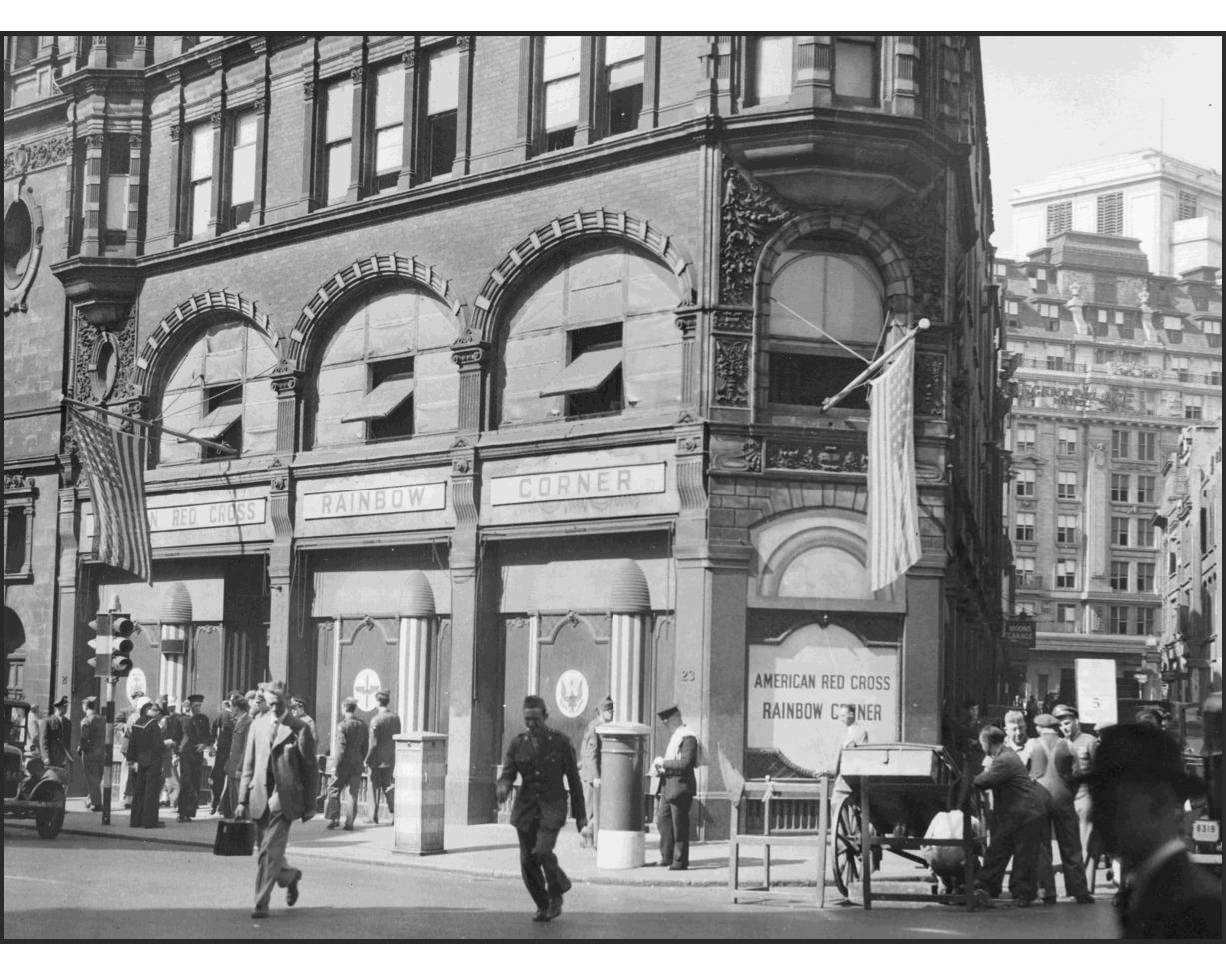
It was known as the American Red Cross Club for US servicemen, or Rainbow Corner, and it was open 24/7, the door key having been symbolically thrown away.
It had a canteen, a few beds, and a ‘where am I?’ cubicle for those too tired or drunk, named after occupants’ first words when they woke. There was a ‘quiet room’, enquiries desk, laundry, barbers, first aid, showers, a games room with free pinball machines, and sightseeing tours. In the basement ‘Dunker’s Den’, servicemen could buy doughnuts, ice cream, sodas and burgers, then dance to a jukebox ’til 3am; British volunteer hostesses ensured enough dance partners. Glenn Miller, Artie Shaw and a young Petula Clark were among those providing entertainment. It was a slice of America for homesick GIs.
← In this view, ornate Lyons windows, blacked-out, survive on the ground floor. It’s doubtful GIs knew or cared about the building’s history. The Regent Palace Hotel is in the background.
The limited space of the former Maison Lyons, the huge demand for the services of Rainbow Corner, and the under-utilisation of the ailing Monico next door resulted in the club borrowing some of the Monico saloons. A sketch of a wrestling match at the club published in the Illustrated London News in 1945 shows the location to be the International Hall. Rainbow Corner also hosted boxing bouts yards from the original Pelican Club; these events often pitted Briton against American.
The club also attracted the great and the good. Dwight Eisenhower looked in; Adele Astaire (aka Lady Charles Cavendish), Fred’s sister and former dance partner, was a member of the Red Cross and helped GIs write letters to family and girlfriends back home. Business dropped off after the D-Day landings with so many soldiers otherwise occupied, but life went on: Fred Astaire dropped in to see his sister, incoming results of the 1944 US presidential election were listened to live, and thanksgiving was celebrated much to the detriment of the turkey population. British ‘GI brides’ went to the club to hear talks on how to adapt to living in the US, including lessons in the art of dunking, and indeed spelling, do(ugh)nuts. A replica of the interior was created for wartime film I Live in Grosvenor Square (1945), a comedy-drama starring David Niven.
Over its lifetime an estimated 400,000 snacks were sold, 300,000 men went on organised tours and 18,000,000 men came through the doors. One volunteer was Irene Whittaker, who became the resident seamstress and surrogate mother to many; she had two American warplanes named after her. British youths tried to get into the club to experience the American dream they’d seen on the big screen, but few succeeded. What shocked many Americans was the lack of segregation at the club, which caused occasional tension between GIs. They were also shocked by the hoards of prostitutes outside, which caused tension between American authorities and the more laid-back Metropolitan Police, but it was inevitable that Piccadilly’s traditional trade would enjoy boom times with so many young American men around, far from home. Something else that boomed was the trade in the black market goods and weapons that GIs could easily source. It’s been suggested Rainbow Corner encouraged a whole new generation of spivs; it remained a meeting point for them long after the GIs had departed.
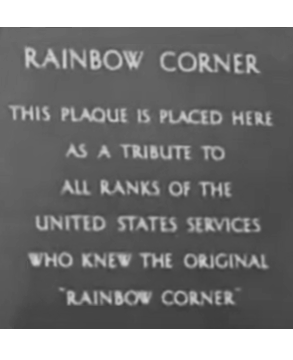
The club finally closed in January 1946; Eleanor Roosevelt and Anthony Eden attended an emotional last night. There were chaotic scenes; the symbolic locking of the door was delayed by huge crowds outside trying to get in, and with the band and crowds inside – having grabbed fittings as souvenirs – trying to get out. The band eventually made it and played on the pavement, the doors were locked, and a sign saying “out of bounds to troops” nailed to the door. The club passed into history.
The building became offices and it was soon besieged again when the Ontario Emigration Office opened a one-stop shop for British applicants on the first floor. Charles Forte opened one of his milk bars on the ground floor; the coffee must have been an inviting prospect for any nostalgic ex-GIs visiting London. He also paid for a commemorative plaque, unveiled in 1949, to celebrate Rainbow Corner. This vanished when the building fell to the same wrecking ball that took out the Monico.
![]() Hairpins, Nobbo & Jamie Oliver: The life and times of a local pub
Hairpins, Nobbo & Jamie Oliver: The life and times of a local pub
On the western corner of the block stands the Devonshire, a gastro-pub, an upmarket cousin of the humble tavern. However, the exterior still has the feel of a 19th century working men’s alehouse. It began life in 1793 as the Devonshire Arms, named in honour of the Duke of Devonshire, whose London home stood on Piccadilly until 1923.
It didn’t have a successful 19th century: The lease frequently came up for auction and in 1837 one landlord, W. Matthews, was declared bankrupt. Tragedy struck five years later, when a cabinet maker’s wife living a few doors up the street accidentally set fire to her clothes when attempting to remove from her hearth a pot of French polish that had boiled over while being prepared. She fled into the pub where customers put out the flames but, terribly burned, she died soon after. The inquest, as so often in those days, was held at the nearest pub: The Devonshire Arms of course. The husband was too distraught to attend.
In 1894 a police constable was called to eject a group of drinkers. Once outside, they attacked him; he summoned assistance by whistle but the fight continued as a large crowd looked on until one constable was stabbed in the back by a woman wielding a hairpin. Six arrests were made. In 1897, the pub billiard room was the meeting place for a blackmailing gang; press reports didn’t detail the exact nature of the crimes but hinted at many victims of the “highest social standing”, that the gang got away with it only due to the reluctance of the victims to prosecute, and that one victim, for reasons unspecified, had been murdered. A solicitor stated that police had knowledge of the gang “which, if publicly stated, would make a story of unparalleled sensation.” Intriguingly, no further reports on the case appeared.
The mood, if not social class, improved considerably on 19th June 1903 when the pub was the finishing line for a race: The Shoeblacks’ Walk. Shoeblacks are those who, in the streets and shopping arcades, clean shoes for payment. Walking races were quite the fashion, and this one had been proposed by the landlord of the Devonshire Arms, Mr. G. Chapman. Cash prizes were offered, and competitors finishing the race would get a hearty breakfast.
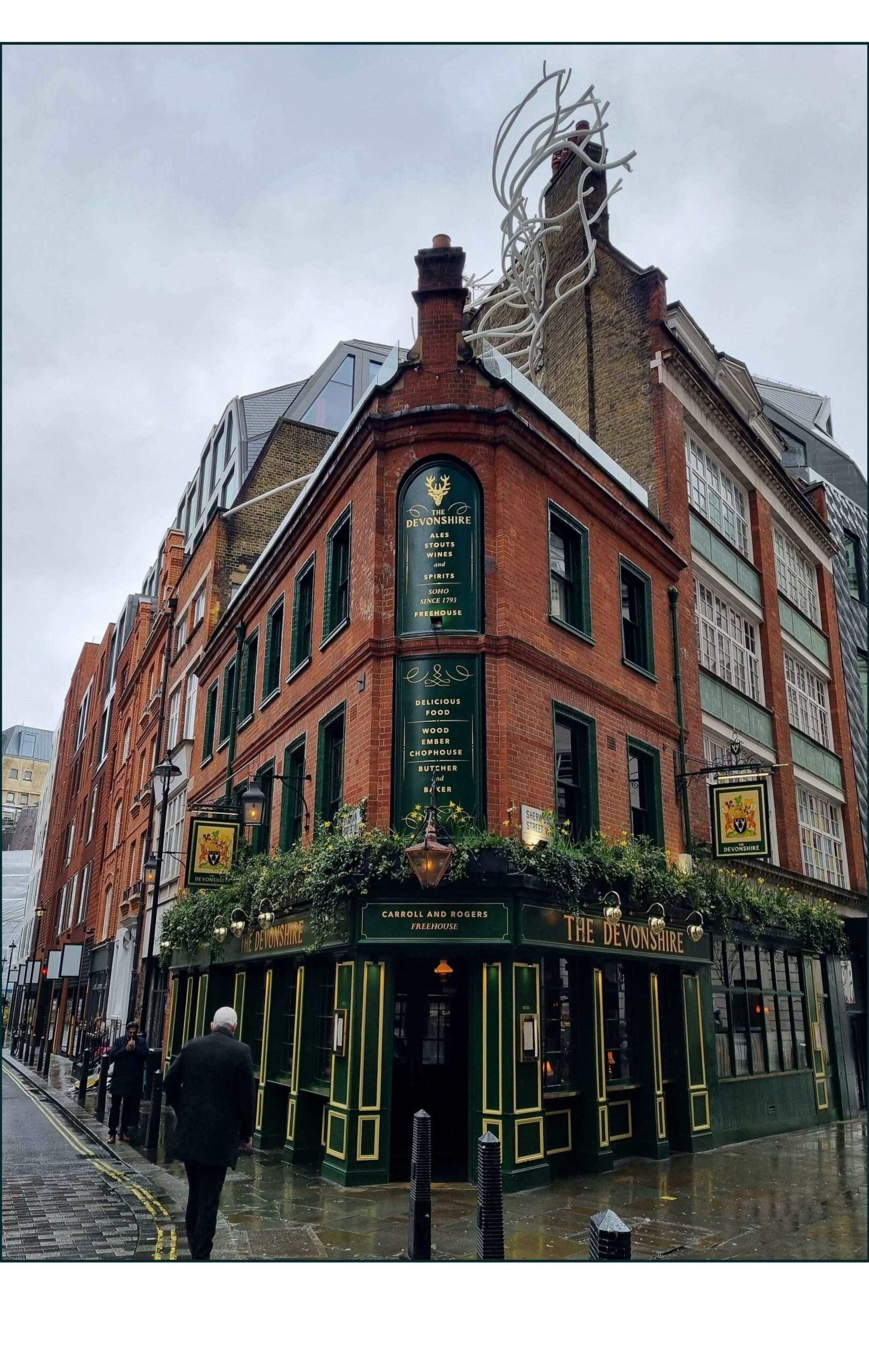
It started at 7:30am from the King and Queen pub on Paddington Green. One condition was that the ‘knights of the brushes’, as they were known, had to carry all their work equipment with them during the race. What is most intriguing is the list of entrants. To name a few: Leicester Square Joe, Piccadilly Kruger, Criterion Snob, Long Bob, Nixey, White-faced Jim, Soldier Tom, Lucky Dan, Old Punch, Horsey, Nobbo and Screw. The Sporting Life was the only journal to consider the event newsworthy, faithfully recording the buildup and result: Long Byke won by 50 yards from Joe Holman, followed by Harry Gloucester and Midget Barrows.
With that, it seems the Devonshire Arms had had enough excitement, and nothing remotely earth-shattering has happened since, although it has had an identity crisis: Despite appearing the quintessential unchanging English pub, it has had several incarnations in the 21st century. For five years it was part of celebrity chef Jamie Oliver’s Jamie’s Italian chain before that went bust; it then became the Coqbull bar for three years. It has now returned to the name and style that suit it best, and remains the oldest, simplest, and arguably the most attractive building on the Monico block.
![]() A Russian Roundabout: The Café Monico site reused
A Russian Roundabout: The Café Monico site reused
In 1963 the Eros was joined by a second cinema – a rather odd one. Following the 1959 demolition of most of the Monico, and delays to the planned redevelopment, the Monico site in the centre of the block was used to construct the experimental Circlorama in just sixty-three days. It cost £100,000 (£1.7m today) and held 500, with space for a further 1000 waiting in ante-rooms. An entrance was provided on Denman Street, with a second entrance later pushed through the unfortunate former Van Raalte’s, to give a more visible presence on Piccadilly Circus. The audience had to stand in the middle of a circular space, surrounded by eleven rectangular screens, each four metres in width. Films were custom-made; the opening feature was Russian Roundabout from the USSR.
→ Building the Circlorama, 1963. The London Pavilion (Avenue facade) is top left; the two arches below the Bristol cigarette hoarding are the remains of the 1890 Monico entrance, with remnants of the opulent interior on the right behind the bricks.
The Times film critic was unimpressed. The colour and image of adjacent screens sometimes didn’t match, and there was “the sheer pointlessness of what we are shown, a notable instance being a sequence about 11 wooden swans which rotate on a pond”. He continued: “It seems calculated to appeal to the same audience that keeps West End cartoon and news theatres in business, except, unfortunately, that what they want for the most part is somewhere comfortable to sit down for an hour.” Eventually the Russian film was replaced by the British-made Circlorama Cavalcade, but the experiment failed and closed within two years. Classic, now the owner of the Eros close by, took the critic’s hint and refitted the Circlorama as a conventional cinema with 270 seats. Initially it showed cartoons but then went over to revivals of recent films. The Denman Street entrance closed, reopening briefly to ease congestion in the cinema’s finest hour: The London premiere of Easy Rider, which ran around the clock from the 4th to the 7th September 1969 to satisfy demand and continued to play for months.
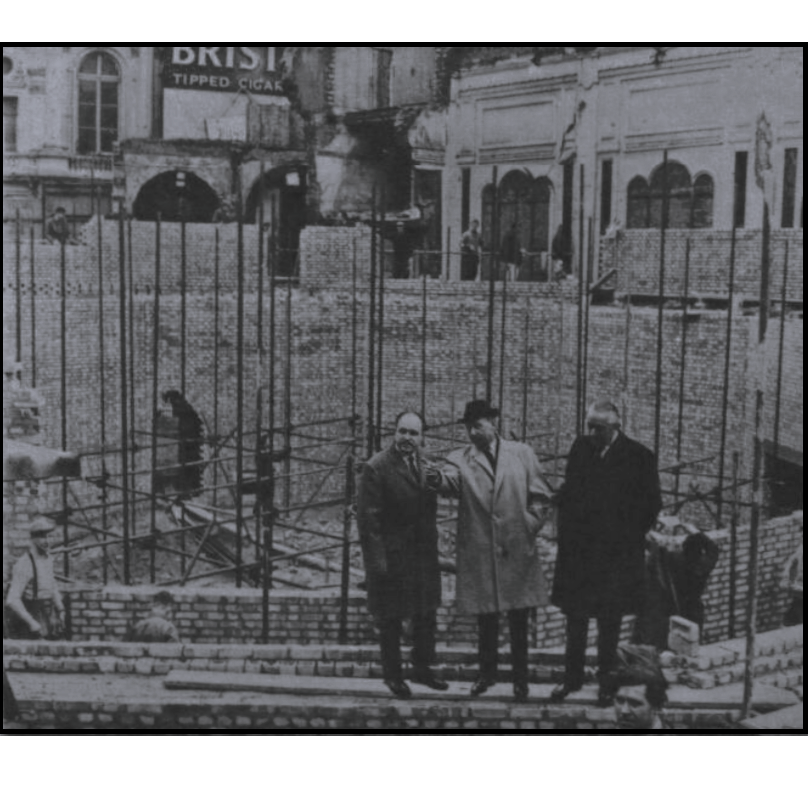
![]() The Monico Up-to-Date: Into the 21st Century
The Monico Up-to-Date: Into the 21st Century
By the late 1970s conservationists had won the battle to preserve Piccadilly Circus. There would be no concrete towers and elevated walkways, nor a Norman Shaw-esque squaring off to make the circus a sensible shape, despite there being little of architectural value left to save on the Monico site. The Classic (former Circlorama), by now showing ‘sexploitation’ films, and what survived of the mutilated former 14-17 Tichborne Street behind the neon signs, were finally demolished in 1976-7. Two simple glass-fronted stores were constructed, and opened as a Wimpy and a Boots. The latter’s Criterion branch, first opened in 1925, was heading for closure due to that building’s impending renovation. By the time Boots returned to the Monico block it was the main source of prescription drugs for West End addicts, and late at night there would be queues for the following day’s fix, available from midnight.
The remaining gaps in the Monico block were redeveloped in an underwhelming 1980s style. The increasingly decrepit Piccadilly Mansions survived again, although the Eros cinema within it closed in 1985 and the space returned to retail. In 1998 the lights began to go digital, then ultra-HD in 2017. A far more comprehensive redevelopment known as the Lucent has just been completed, involving the entire site save for the Devonshire. Fifty-six years after the demolition of the restaurant, the Lucent planning application still referred to the site as ‘the Monico’. The architects’ approach was to save the best of the surviving older facades, which ironically included half of the ‘totally uninspired’ Piccadilly Mansions, and the two 1980s shops beneath new offices hidden behind the Piccadilly Lights. The Lucent is barely any taller than the replaced buildings, and the project was finished without having to take down that pesky display that tourists come to Piccadilly Circus to see.
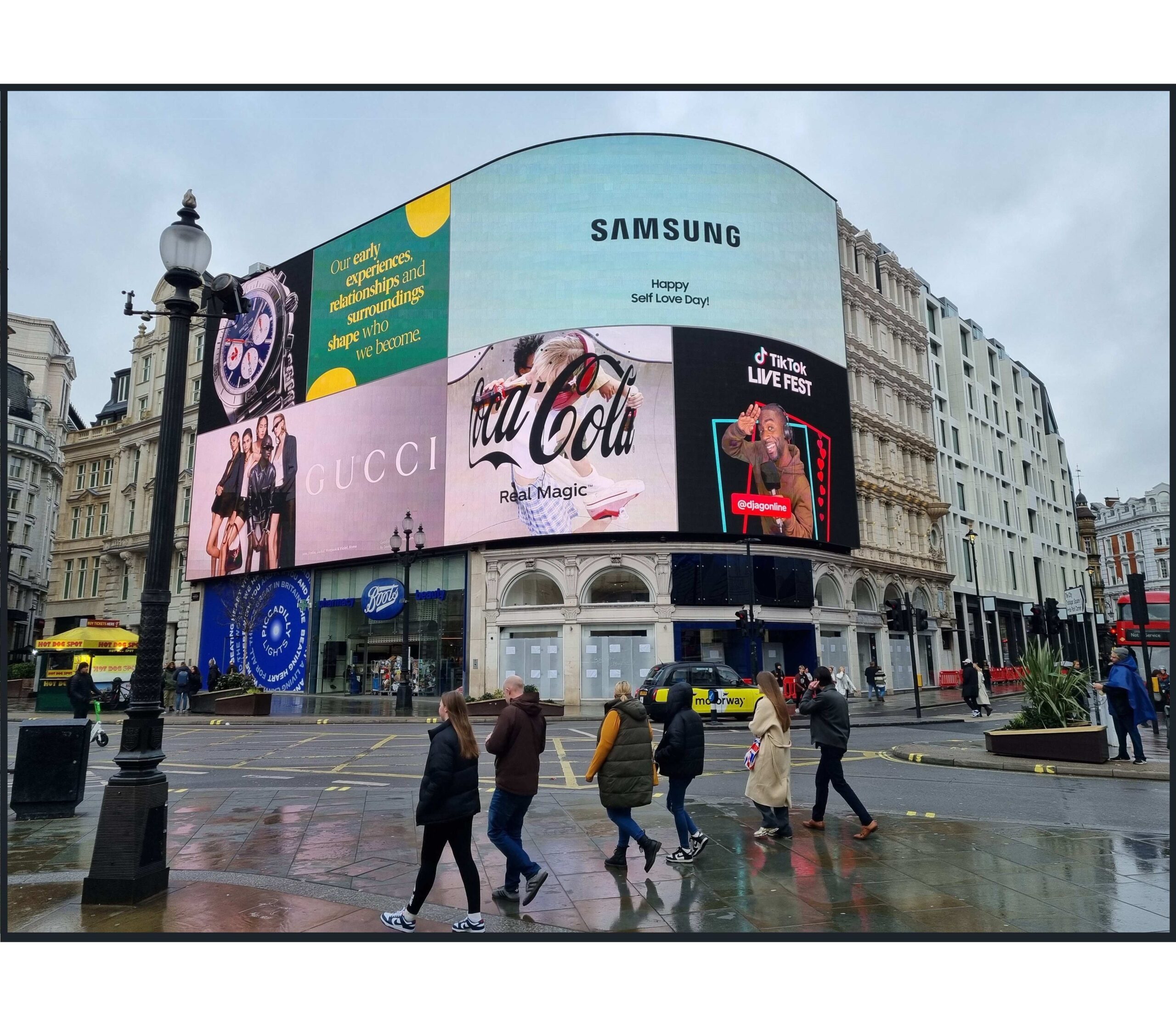
The visible half of Piccadilly Mansions, facing the London Pavilion, has been rebuilt behind a realigned and renovated facade that sadly received an extra storey and more tedious roofline, making it look top-heavy and even less inspiring than it was in 1891. As for the invisible half, the redevelopment seems to have left only the ground floor facade in position; behind the lights are modern offices.
← The view from Piccadilly Circus today. The arched ground floor facade of Piccadilly Mansions still exists, and Boots the Chemist continues to occupy part of the site. The block now consists of retail, offices, leisure facilities and apartments.
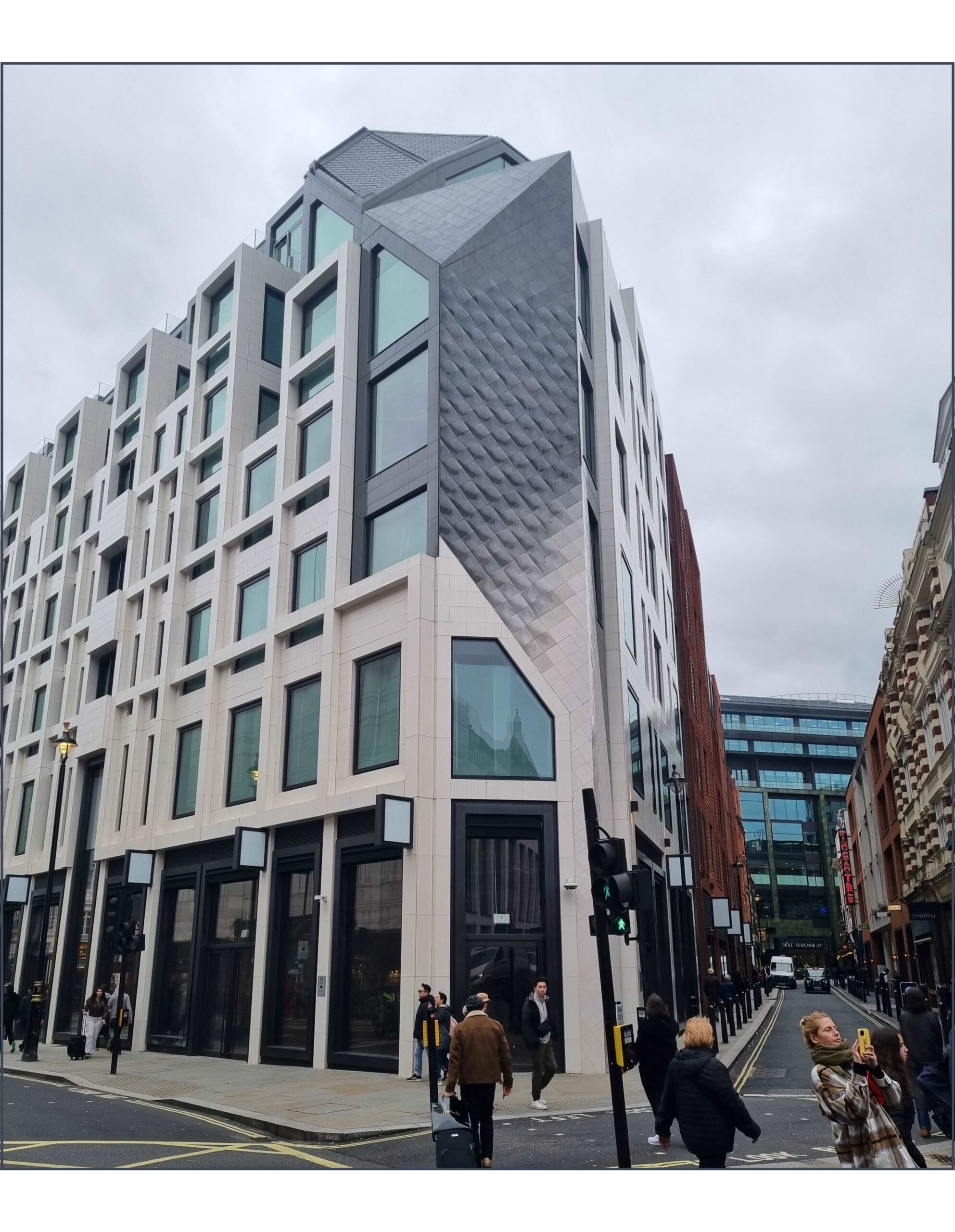
As for Rainbow Corner, the developers claim it will be celebrated once more, although it’s unclear how, and no commemorative plaque has been placed on the building. Actress Celia Imrie has got in first by writing a novel centred on the club: Meet Me at Rainbow Corner is due to be published in July this year. Perhaps that will help to revive interest.
← Rainbow Corner today. In the background, the Regent Palace Hotel has closed and been partially redeveloped.
The history of the Monico block, the poor relation of the Piccadilly Circus family, is fascinating but there must be a reality check here. Only the pub and its immediate neighbours, five minor facades on Glasshouse Street and Denman Street, and the mutilated remnants of Piccadilly Mansions survive from its glory days. Perhaps the proposed destruction of Piccadilly Circus itself could only be stopped if a sacrifice was made; maybe the Criterion, London Pavilion, Swan and Edgar building and County Fire Office only survived because the Café Monico and Rainbow Corner were bulldozed in crazed pursuit of that absurd 14-storey tower.
Postscript: The Monico name was revived in 2017 for a restaurant a little further up Shaftesbury Avenue, between the Gielgud and Queen’s theatres. Several reviewers showed their ignorance by stating that this was the site of the original, but more importantly most just didn’t like the food. It closed during the pandemic, never to reopen. It was an odd attempt at a revival; the days of the vast middle-class restaurants like the Monico, Trocadero and Criterion are long past, and the Monico’s name almost forgotten. What’s gone is gone, and we must move on.

Nearest Station: Piccadilly Circus
Selected Bibliography:
Credits: